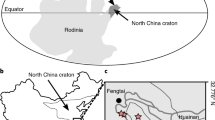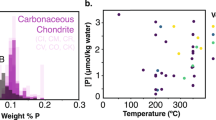Abstract
There was a significant oxidation of the Earth's surface around 2 billion years ago (2 Gyr)1,2,3,4. Direct evidence for this oxidation comes, mostly, from geological records of the redox-sensitive elements Fe and U reflecting the conditions prevailing during weathering1,2,3. The oxidation event was probably driven by an increased input of oxygen to the atmosphere arising from an increased sedimentary burial of organic matter between 2.3 and 2.0 Gyr5. This episode was postdated by the final large precipitation of banded iron formations around 1.8 Gyr1,2. It is generally believed that banded iron formations precipitated from an ocean whose bottom waters contained significant concentrations of dissolved ferrous iron, and that this sedimentation process terminated when aerobic bottom waters developed, oxidizing the iron and thus removing it from solution1,2. In contrast, I argue here that anoxic bottom waters probably persisted until well after the deposition of banded iron formations ceased; I also propose that sulphide, rather than oxygen, was responsible for removing iron from deep ocean water. The sulphur-isotope record supports this hypothesis as it indicates increasing concentrations of oceanic sulphate, starting around 2.3 Gyr6, leading to increasing rates of sulphide production by sulphate reduction. The increase in sulphide production became sufficient, around 1.8 Gyr, to precipitate the total flux of iron into the oceans. I suggest that aerobic deep-ocean waters did not develop until the Neoproterozoic era (1.0 to ∼0.54 Gyr), in association with a second large oxidation of the Earth's surface. This new model is consistent with the emerging view of Precambrian sulphur geochemistry and the chemical events leading to the evolution of animals, and it is fully testable by detailed geochemical analyses of preserved deep-water marine sediments.
This is a preview of subscription content, access via your institution
Access options
Subscribe to this journal
Receive 51 print issues and online access
$199.00 per year
only $3.90 per issue
Buy this article
- Purchase on Springer Link
- Instant access to full article PDF
Prices may be subject to local taxes which are calculated during checkout


Similar content being viewed by others
References
Cloud, P. E. J Aworking model of the primitive Earth. Am. J. Sci. 272, 537–548 (1972).
Holland, H. D. The Chemical Evolution of the Atmosphere and Oceans (Princeton Univ. Press, Princeton, (1984)).
Holland, H. D. & Beukes, N. Apaleoweathering profile from Griqualand West, South Africa: evidence for a dramatic rise in atmospheric oxygen between 2.2 and 1.9 bybp. Am. J. Sci. 290-A, 1–34 (1990).
Des Marais, D. J., Strauss, H. Summons, R. E. & Hayes, J. M. Carbon isotope evidence for the stepwise oxidation of the Proterozoic environment. Nature 359, 605–609 (1992).
Karhu, J. A. & Holland, H. D. Carbon isotopes and the rise of atmospheric oxygen. Geology 24, 867–870 (1996).
Hayes, J. M., Lambert, I. B. & Strauss, H. in The Proterozoic Biosphere: A Multidisciplinary Study (eds Schoff, J. W. & Klein, C.) 129–134 (Cambridge Univ. Press, (1992)).
Sarmiento, J. L., Herbert, T. D. & Toggweiler, J. R. Causes of anoxia in the world ocean. Glob. Biogeochem. Cycles 2, 115–128 (1988).
Ridge/vents Workshop Group. In Global Impact of Submarine Hydrothermal Processes (eds Kadko, D., Baker, E., Alt, J. & Baross, J. 4–15 (NSF RIDGE Initiative and NOAA Vents Program, (1994)).
Shaffer, G. Biogeochemical cycling in the global ocean 2. New production, Redfield ratios, and remineralization in the organic pump. J. Geophys. Res. 101, 3723–3745 (1996).
Emerson, S., Quay, P. D., Stump, C. & Schudlich, R. Chemical tracers of productivity and respiration in the subtropical Pacific Ocean. J. Geophys. Res. 100, 15873–15887 (1995).
Knoll, A. H. in Origin and Early Evolution of the Metazoa (eds Lipps, J. H. & Signor, P. W.) 53–84 (Plenum, New York, (1992)).
Canfield, D. E. & Teske, A. Late proterozoic rise in atmospheric oxygen concentration inferred from phylogenetic and sulphur-isotope studies. Nature 382, 127–132 (1996).
Berkner, L. V. & Marshall, L. C. On the origin and rise of oxygen concentration in the Earth's atmosphere. J. Atmos. Res. 22, 225–261 (1965).
Knoll, A. H., Hayes, J. M., Kaufman, A. J., Swett, K. & Lambert, I. B. Secular variation in carbon isotope ratios from Upper Proterozoic successions of Svalbard and East Greenland. Nature 321, 832–838 (1986).
Cameron, E. M. Sulphate and sulphate reduction in early Precambrian oceans. Nature 296, 145–148 (1982).
Harrison, A. G. & Thode, H. G. Mechanisms of the bacterial reduction of sulfate from isotope fractionation studies. Trans. Faraday Soc. 53, 84–92 (1958).
Ohmoto, H., Kakegawa, T. & Lowe, D. R. 3.4-billion-year-old biogenic pyrites from Barberton, South Africa: Sulfur isotope evidence. Science 262, 555–557 (1993).
Habicht, K. S. & Canfield, D. E. Sulphur isotope fractionation in modern microbial mats and the evolution of the sulphur cycle. Nature 382, 342–343 (1996).
van Cappellen, P. & Wang, Y. in Metal Contaminated Sediments (ed. Allen, H. E.) 21–64 (Ann Arbor, Chelsea, Michigan, (1995)).
Berner, R. A. & Raiswell, R. Burial or organic carbon and pyrite sulfur in sediments over geologic time. Geochim. Cosmochim. Acta 47, 855–862 (1983).
Beukes, N. J. & Klein, C. in The Proterozoic Biosphere: A Multidisciplinary Study (eds Schoff, J. W. & Klein, C.) 147–151 (Cambridge Univ. Press, (1992)).
Logan, G. A., Hayes, J. M., Hieshima, G. B. & Summons, R. E. Terminal Proterozoic re-organization of biogeochemical cycles. Nature 376, 53–56 (1995).
Schieber, J. Anomalous iron distribution in shales as a manifestation of “non-clastic iron” supply to sedimentary basins: relevance for pyritic shales, base-metal mineralization, and oolitic ironstone deposits. Mineral. Deposita 30, 294–302 (1995).
Canfield, D. E., Lyons, T. W. & Raiswell, R. Amodel for iron deposition to euxinic Black Sea sediments. Am. J. Sci. 296, 818–834 (1996).
Raiswell, R. & Canfield, D. E. Sources of iron for pyrite formation in marine sediments. Am. J. Sci. 298, 219–245 (1998).
Imbus, S. W., Macko, S., Elmore, R. D. & Engel, M. Stable isotope (C,S,N) and molecular studies on the Precambrian Nonesuch Shale (Wisconsin–Michigan, USA): evidence for differential preservation rates, depositional environment and hydrothermal influence. Chem. Geol. 101, 255–281 (1992).
Jackson, M. J. & Raiswell, R. Sedimentology and carbon–sulphur geochemistry of the Velkerri Formation, a mid-Proterozoic potential oil source in northern Australia. Precambr. Res. 54, 81–108 (1991).
Vidal, G. & Nystuen, J. P. Micropaleontology, depositional environment, and biostratigraphy of the Upper Proterozoic Hedmark Group, Southern Norway. Am. J. Sci. 290-A, 170–211 (1990).
Canfield, D. E. The geochemistry of river particulates from the continental United States: major elements. Geochim. Cosmochim. Acta 61, 3349–3365 (1997).
Milliman, J. D. & Syvitski, J. P. M. Geomorphic/tectonic control of sediment discharge to the ocean: the importance of mountainous rivers. J. Geol. 100, 525–544 (1992).
Acknowledgements
I thank J. Hayes, B. Thamdrup, D. Des Marais and A. Knoll for comments on the manuscript. Financial support came from the Danish National Science Research Council (SNF) and the Danish National Research Foundation (Danmarks Grundforskningsfond). This Letter is dedicated to the memory of H. Jannasch.
Author information
Authors and Affiliations
Corresponding author
Rights and permissions
About this article
Cite this article
Canfield, D. A new model for Proterozoic ocean chemistry. Nature 396, 450–453 (1998). https://doi.org/10.1038/24839
Received:
Accepted:
Issue Date:
DOI: https://doi.org/10.1038/24839
This article is cited by
-
Soft-sediment deformation structures or microbially induced sedimentary structures: the description and possible origin of the "loopites" in the Mesoproterozoic Wumishan Formation, North China
Carbonates and Evaporites (2024)
-
Biogeochemistry of Earth before exoenzymes
Nature Geoscience (2023)
-
Dynamic redox and nutrient cycling response to climate forcing in the Mesoproterozoic ocean
Nature Communications (2023)
-
Methane formation driven by light and heat prior to the origin of life and beyond
Nature Communications (2023)
-
Eukaryogenesis and oxygen in Earth history
Nature Ecology & Evolution (2022)
Comments
By submitting a comment you agree to abide by our Terms and Community Guidelines. If you find something abusive or that does not comply with our terms or guidelines please flag it as inappropriate.



